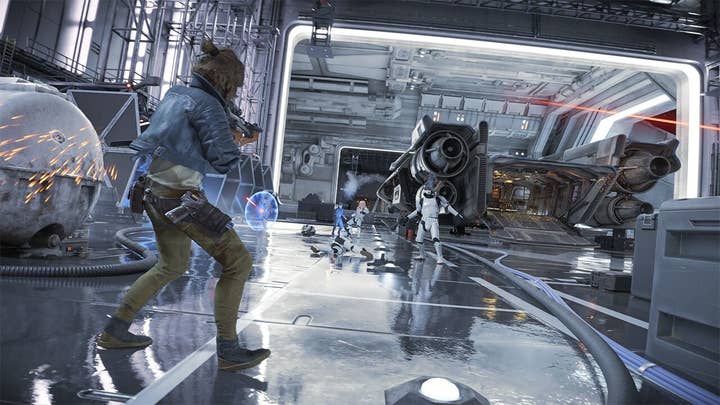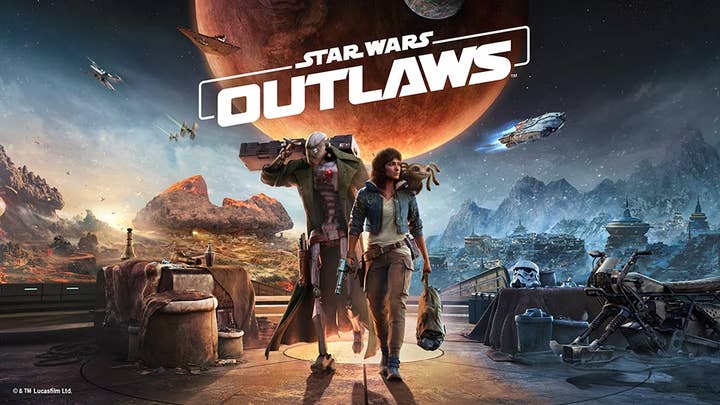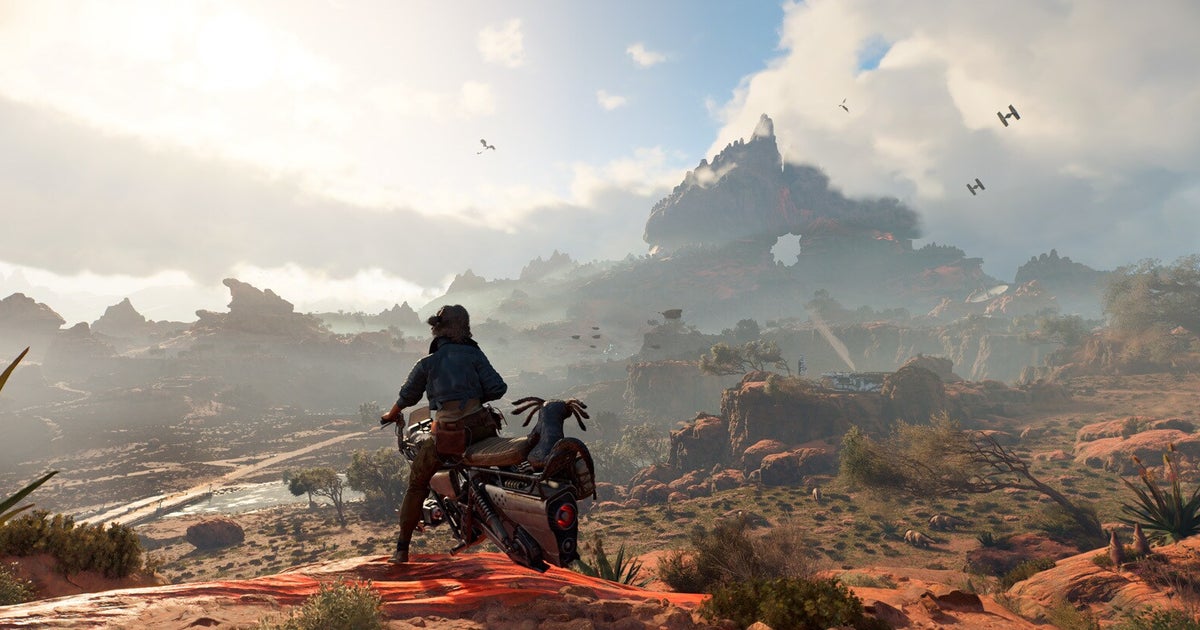It’s E3 2018 and Julian Gerighty is preparing to take the stage at The Orpheum Theater to present The Division 2.
As the creative director prepared for Ubisoft’s press conference, his boss at the time – Ubisoft Massive CEO David Polfeldt – sat outside in a cafe “chatting” with Disney about the possibility of the two working together.
“They had a shortlist of developers they wanted to work with, and Massive just happened to be on that list,” Gerighty tells us. “David was really excited about that relationship as well.
“I wasn’t sure if we would work on Star Wars. It could have been other Disney properties. But inside of all of us, we all dream of making a Star Wars game one day. So that was the starting point.”
This isn’t the first time I’ve heard of a major licensing deal coming out of an E3 meeting. In fact, the following year at E3 2019, Disney met with Rare, which led to the addition of Pirates of the Caribbean to Sea of Thieves.
“It’s that concentration of everyone in the same place, instead of one person being on this end of town, and this person being on this end of town,” Gerighty says. “I mourn E3 because we don’t have those moments anymore.”
Star Wars Outlaws is one of two major licensed productions being developed alongside each other at Ubisoft Massive, the other being Avatar: Frontiers of Pandora from last December. The Swedish studio has expanded considerably as a result, partnering with more co-developers.
“It’s gotten bigger and bigger,” Gerighty says.[Mario + Rabbids developer] Ubisoft Milan is a brand new collaboration with us. We’ve never worked with them before and they’ve done a phenomenal job. Their animation work is amazing.
“The team at Massive has grown. We’ve also hired a lot of people because of Avatar. But generally we’ve found people who share the same DNA. The person who controls the speeder and the ship comes from Criterion, who worked on Battlefront. It’s a small industry and people are really passionate about working on Star Wars.”
“I mourn E3 because we no longer have these moments”
Despite the expansion, Gerighty says the core team behind Star Wars Outlaws is the same group that worked on The Division 2 and has been together for over a decade. Still, this was new territory. While The Division was technically a licensed IP (it’s part of the Tom Clancy universe), working on Star Wars would inevitably entail a lot more oversight.
“It’s actually been surprisingly easy and super fun,” Gerighty says. “From day one, we worked closely with Lucasfilm Games and built a creative framework together. It was an open-world, action-adventure game, single-player, with the scoundrel archetype. At the time, we called it The Scoundrel Archetype, which is Star Wars-speak for space pirate or outlaw. And from there, we learned Star Wars design, Star Wars visuals, Star Wars twists, Star Wars stories, and that allowed everyone on the team to level up.
“We love worlds, we love building worlds, and Star Wars has a certain simplicity that really helped us elevate our game.”
Star Wars lore has grown more complex in recent years, with numerous live-action and animated series popping up alongside the films. And the key to managing this growing complexity has been to focus on what makes sense for the story they’re telling.
“It was decided almost on day one that we were an original trilogy,” Gerighty says. “We were between Empire Strikes Back and Return of the Jedi . And from that point on, I don’t care about anything. It’s telling a new story with familiar threads. It’s a villain story, so maybe you don’t run into people who don’t really belong in a villain story. Leia might not make sense, but Qi’ra, Jabba the Hut, Lando… absolutely. You don’t want the galaxy to feel too small by just doing the greatest hits of all the Star Wars characters.”

The decision to focus on the original trilogy influenced Massive’s entire approach to Outlaws. The team would call Lucasfilm Games at least once or twice a week, and leaned on the license holder when it came to recreating that ’70s Star Wars look.
“We have developed a lens for use in [game engine] snowdrop, a camera lens, which mimics the cinema lenses of the 70s,” Gerighty says. “So when you look, you see slight distortion. There’s a Panavision lens vignetting, chromatic aberration. There’s lens flare. All of these things are there to remind you of the lenses of the original trilogy through new technology. We actually worked with Lucasfilm to get the camera values for Rogue One to be as close to the original trilogy as possible, but through the lens of modern technology.
He continues: “We love it here, so we present everything in the ultra-wide format, to give it that cinematic presentation.”
“There is an added pressure of ‘you can’t screw this up'”
The team’s production director – someone responsible for things like cinematics, transitions, on-set acting, dialogue choices, etc. – also comes from Industrial Light and Magic, the special effects department responsible for Star Wars.
“He’s worked on multiple Star Wars projects,” Gerighty says. “He basically studied how things were done in the original trilogy. The scene setups, the classic screen wipes that you might have noticed when you die… little things like that, that remind you that this is the best galaxy ever created.”
The demos we played in LA certainly felt cinematic, but they were all linear set pieces designed to showcase different elements of the game. Star Wars Outlaws is an open world game, and players can explore and play at their own pace. Doesn’t that make it difficult to fully deliver that cinematic experience?
“It never occurred to me,” Gerighty insists. “Video games, to me, aren’t about linear content. It’s more about the agency of the player to do what they do. So when we talk about cinematography, it’s the execution that’s cinematic, not necessarily that this is a linear story.
“The opportunity that games have is that they give you the director’s chair. You’re the one who decides those things. That, to me, is why video games are such a beautiful art form.”

Ubisoft is known for its massive open-world experiences like Assassin’s Creed and Far Cry. And one criticism the company has faced over the years is that those experiences can feel familiar. Gerighty says Massive is aware of that, and that Outlaws is a Star Wars game, not a Ubisoft game with Star Wars plastered on top.
“We’re hyper-aware of Ubisoft’s branding,” Gerighty says. “Massive has always been different. The Division and The Division 2 were different. Originally Massive was an independent studio, then an Activision studio, so it’s always thought very differently. The DNA of Massive is quite unique to Ubisoft. But there are so many great lessons to be learned from the way Ubisoft makes games.
“And Star Wars itself proposed a number of different ways of doing things. I’ll give you an example. Instead of having a skill tree and an upgrade tree like in a traditional game, here you seek out experts to create this padawan/master relationship in the world, who will lead you on adventures to upgrade your character. It’s all baked into the people and the world.”
Star Wars Outlaws has gone gold and there are high expectations for this game. It’s one of the world’s best game developers making a game based on one of the world’s most popular media franchises. It’s also coming after a very quiet period for AAA game releases. So there will be a lot of eyes on this game when it comes out in late August.
“There’s pressure to deliver a really good game every time we release a game,” Gerighty concludes. “But because this is a childhood dream come true for a lot of us, there’s that added pressure of ‘you can’t mess this up.’ But we’re proud of what we’ve delivered.”
